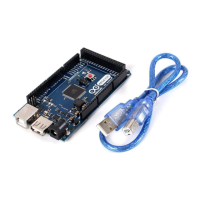
Do you have a question about the Arduino Mega ADK and is the answer not in the manual?
| Microcontroller | ATmega2560 |
|---|---|
| Operating Voltage | 5V |
| Input Voltage (recommended) | 7-12V |
| Input Voltage (limits) | 6-20V |
| Digital I/O Pins | 54 |
| PWM Pins | 15 |
| Analog Input Pins | 16 |
| DC Current per I/O Pin | 20 mA |
| DC Current for 3.3V Pin | 50 mA |
| Flash Memory | 256 KB |
| SRAM | 8 KB |
| EEPROM | 4 KB |
| Clock Speed | 16 MHz |
| USB Host Shield | Yes |
| Android Accessory Interface | Yes |
| USB Host Chip | MAX3421E |
Details on powering the board via USB, external adapter, or battery, including voltage requirements and current limits.
Explanation of VIN, 5V, 3V3, GND, and IOREF pins for managing power input and output on the board.
Details on the MEGA ADK's flash memory, SRAM, and EEPROM capacities for code storage and data.
Overview of digital pins, their modes, current limits, and specialized functions like Serial, Interrupts, PWM, and SPI.
Explanation of TTL serial (UART), TWI (I2C), and SPI communication protocols supported by the ATmega2560.
Details on the MAX3421E IC for USB host functionality, enabling interaction with various USB devices.
Information on uploading code via bootloader, ICSP, and ATmega8U2 firmware programming (DFU mode).
How the DTR line facilitates automatic resets for code uploads and its behavior on different operating systems.
Description of the resettable poly fuse protecting USB ports from shorts and overcurrent.
Details on PCB dimensions, screw holes, and compatibility with shields designed for other Arduino models.
